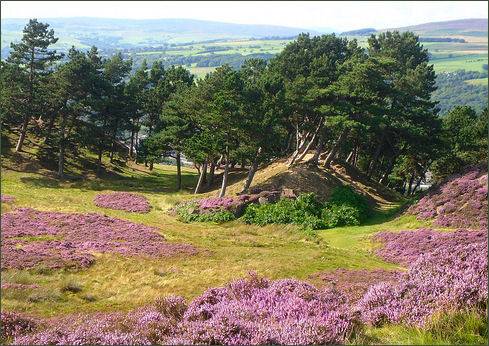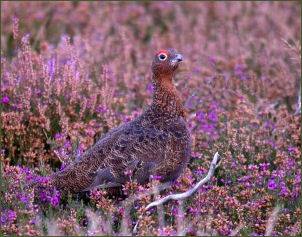Ilkley Moor
OS grid reference:- SE 114 452
 Ilkley Moor forms part of Rombalds Moor, which roughly bordered by the spa town of Ilkley in the north, Silsden in the west, Keighley in the south and Menston in the east. The moor, which rises to 402 metres (1,319 feet) above sea level, is famous as the inspiration for Yorkshire's unofficial national anthem 'On Ilkla Moor Baht 'at' and is also a Site of Special Scientific Interest due to its upland habitat for ground-nesting birds.
Ilkley Moor forms part of Rombalds Moor, which roughly bordered by the spa town of Ilkley in the north, Silsden in the west, Keighley in the south and Menston in the east. The moor, which rises to 402 metres (1,319 feet) above sea level, is famous as the inspiration for Yorkshire's unofficial national anthem 'On Ilkla Moor Baht 'at' and is also a Site of Special Scientific Interest due to its upland habitat for ground-nesting birds.
Two rock climbing areas, Rocky Valley and Ilkley Quarry are situated to the north, where the moor drops steeply towards the village of Ben Rhydding. Ilkley Quarry is the site of the famous "Cow and Calf", a large rock formation consisting of an outcrop and boulder, also known as Hangingstone Rocks. Legend states that there was once also a "bull", but that was quarried for stone.
 Ilkley Tarn was developed by the Victorians as an ornamental feature, the tarn lies above Ilkley on the edge of the moor. White Wells, a spa bath was built circa 1700 as an open air spa bath, later baths were enclosed and a single plunge pool survives today inside the White Wells Spa Cottage.
Ilkley Tarn was developed by the Victorians as an ornamental feature, the tarn lies above Ilkley on the edge of the moor. White Wells, a spa bath was built circa 1700 as an open air spa bath, later baths were enclosed and a single plunge pool survives today inside the White Wells Spa Cottage.
The most important group of archaeological sites to be found on Ilkley Moor are carved rocks, also known as cup & ring marked rocks. Rombald's Moor can boast the second highest concentration of ancient carved stones in Europe.
On the Woodhouse Crag, on the Northern edge of the moor, there is a swastika-shaped pattern engraved in a stone, known as the Swastika Stone, it is also referred to as a Fylfot. The stone is just one of a great abundance of carved rocks on the moor, well known others include the 'Badger Stone' and 'St. Margaret's Stones'. These are earthfast boulders, large flat slabs or prominent rocks that have cups, rings and grooves cut into them and thought to date from either the late Neolithic or the Bronze Age. While some carvings consist of simple cups, others such as the Badger Stone, Hanging Stones and the Panorama Rocks have complex series of patterns. combining many different elements.
The Grubstones Stone circle (OS grid reference SE 136447) is situated just to the east of the moor on a south facing slope, and has 20 surviving stones. The stones are set on the inside of a low bank, about 1.8 metres wide. South-east of the circle there are several large cairns including The Skirtful of Stones.
The small stone circle known as The Twelve Apostles (OS grid reference SE 126450) stands just over 800 metres north-west of the Grubstones circle, to the northeast of a ridge at about 381 metres above sea level. The circle has a diameter of about 15 metres and originally had between 16 and 20 stones.
Wildlife on Ilkley Moor
 lkley Moor provides a habitat for an abundance of varied wildlife, Lizards, Frogs and Toads inhabit the area and in addition to the common lowland and garden Butterflies there are plenty of Green Hairstreak Butterflies, the only green-coloured butterfly to be found in Britain.
lkley Moor provides a habitat for an abundance of varied wildlife, Lizards, Frogs and Toads inhabit the area and in addition to the common lowland and garden Butterflies there are plenty of Green Hairstreak Butterflies, the only green-coloured butterfly to be found in Britain.
Meadow Pipits are most often sighted, as are Red Grouse, the rare hawk, the Merlin, Britains smallest bird of prey, inhabits the heather moors.
On the higher moor are Curlew, Redshank, Golden Plover, Kestrels, Small Owls, Swallows, Swifts, House Martins, Ravens, Jackdaw and Rooks, there are also a small number of Peregrine Falcons. Among the trees at the edges of the Moor Nuthatches, Treecreepers and Chiffchaffs may be sighted. The winter-visiting Fieldfares and Redwings, Wrens and Robins inhabit the lower slopes of Ilkley Moor.
Much of the flora of the moor consists of grass and rushes, heather and bracken. Wavy Hair-grass covers large patches of the highest parts of the moor, while Cottongrass flourishes in the damper areas. Heather is to be found in three types. Ling is by far the most common, but there are also Bell Heather, and Cross-leaved Heath, Crowberry, which looks very like heather, is also common.
Bilberry and cranberry also grow on the moor. The small yellow flowers of Tormentil are abundant while the carniverous plant Sundew grows in a few places, The Sundew attract, arrest, and absorb insects through stalked glands spread over the surface of their leaves. The insects enrich the meagre mineral nutrition of the soil in which they grow.
